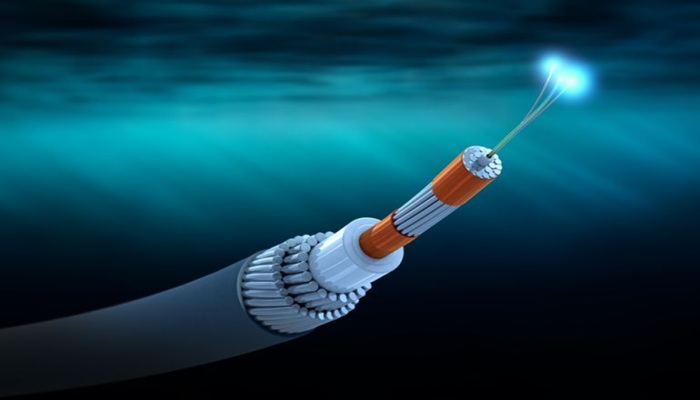
Afrasianet - Today's world is increasingly dependent on digital connectivity, driven by a vital but invisible infrastructure that manages the global Internet and secures the flow of data and financial transactions in an astonishing way.
This infrastructure is represented by submarine fiber optic cables, which carry more than 95% of international data traffic and support financial transactions estimated at about $10 trillion per day. Despite this essential role, this delicate and formidable network remains forgotten, neglected in terms of protection, even though it represents the real backbone of the global digital economy.
These cables, which are only two inches in diameter, stretch for more than 1.2 million kilometers across oceans and are made up of thin optical fibers surrounded by layers of copper, plastic and steel, to protect them from enormous stresses and currents.
Thanks to this design, submarine cables can transmit data at speeds of up to terabytes per second, making them the ideal choice for low-latency applications such as cloud services, live streaming, and financial transactions, thus significantly outperforming satellites with limited speed and greater latency.
Despite popular perception, relying on satellites for international data transmission is only a few percentages, because submarine cables are more efficient, less expensive and faster responsive.
These cables are installed by specialized vessels that launch them into the deep ocean according to carefully studied paths to avoid areas of earthquakes, strong currents and landslides. Paradoxically, more than 70% of the cables' failures are caused by human activities such as overfishing or dumping, rather than natural disasters or marine animal attacks as rumored.
Despite the technical nature of this sector, the political and security aspect is strongly present. Submarine cables are a strategic asset that needs to be protected at a time of geopolitical tensions.
For example, Australia has established protected maritime zones around cable tracks to prevent damage, while the US armed forces rely on them directly to transmit intelligence between their bases and command centers. Any interruption in these cables can lead to paralysis in services, delays in military operations, and a collapse in financial markets, even for hours.
Historically, these cables have not been isolated from wars. In 1959, five U.S. cables were cut under the Atlantic in mysterious circumstances, and Washington accused Soviet ships of deliberate sabotage.
In the modern era, Edward Snowden's leaks have revealed the ability of the US National Security Agency to eavesdrop on transient data through cable intersection points, prompting some countries such as Brazil to create new cables that avoid passing through the United States.
In recent years, fears of deliberate attacks have escalated. In 2023 and 2024, submarine cables were damaged in the Baltic and Red Seas under circumstances deemed suspicious, repositing the question of maritime security in the context of geopolitics.
These incidents, some of which appear to be part of hidden conflicts, underscored the fragility of this infrastructure despite its technical strength. To address these challenges, companies like Google and Meta have resorted to building their own cables, such as the submarine cable Dunant, which crosses the Atlantic and transmits 250 terabytes per second, signaling a silent race between global technological powers to own their own protected networks.
The importance of these cables is not limited to developed countries only, but extends to countries with sensitive geographical locations. Egypt, for example, has more than 16 major submarine cables linking Asia and Europe, giving it a strategically important position on the global communications map. However, this importance is not always accompanied by protection or investment policies commensurate with the size of the "geocyber" assets it holds.
Submarine internet cables remain the digital life network of the modern world. They carry the global economy, feed transactions and information in real time, but at the same time they lack adequate protection and are often managed by private companies, in the absence of a binding international framework. If this continues, the question is no longer whether these cables will be targeted, but when, and how it will affect a world that is more dependent than ever on an uninterrupted flow of data.
In light of the above, and in light of accelerating geopolitical competition and technological advances, submarine cables are emerging not only as a digital infrastructure, but as a highly sensitive strategic asset.
Although reliance on them will continue for decades to come, their future will be determined not only by the development of speeds or the improvement of the buffer layers, but also by the ability of states and international organizations to formulate collective governance and insurance systems.
The world is entering a phase where control over data, not land, is the essence of power. In this context, the depths of the ocean may become a new arena of conflict, silent but influential. Submarine cables are not just data pipes, but arteries of a globalized world that is literally being reshaped from under the sea.
In the Arab world, the presence in the governance landscape of this infrastructure is still marginal, if not completely absent. There is no unified Arab strategy to protect these cables, nor a clear vision to invest in them or participate in the development of their security standards and operation.
In a world where power is managed by controlling the flow of data, ignoring the strategic depth of submarine cables is a kind of strategic shortcoming. Will the Arabs remain just a cable corridor, or will there be someone who will pay attention to this scene and become an active party in drawing the map of global digital security?

